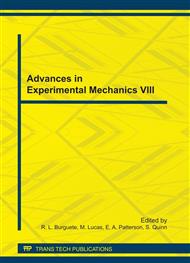p.434
p.440
p.446
p.452
p.458
p.464
p.470
p.476
p.482
The Effect of Plastic Deformation on the Thermoelastic Constant and the Potential to Evaluate Residual Stress
Abstract:
In some metals it has been shown that the introduction of plastic deformation or strain modifies the thermoelastic constant, K. If it was possible to define the magnitude of the change in thermoelastic constant over a range of plastic strain, then the plastic strain that a material has experienced could be established based on a measured change in the thermoelastic constant. This variation of the thermoelastic constant and the ability to estimate the plastic strain that has been experienced, has potential to form the basis of a novel non-destructive, non-contact, full-field technique for residual stress assessment using thermoelastic stress analysis (TSA). Recent research has suggested that the change in thermoelastic constant is related to the material dislocation that occurs during strain hardening, and thus the change in K for a material that does not strain harden would be significantly less than for a material that does. In the work described in this paper, the change in thermoelastic constant for three materials (316L stainless steel, AA2024 and AA7085) with different strain hardening characteristics is investigated. As the change in thermoelastic response due to plastic strain is small, and metallic specimens require a paint coating for TSA, the effects of the paint coating and other test factors on the thermoelastic response have been considered.
Info:
Periodical:
Pages:
458-463
Citation:
Online since:
August 2011
Authors:
Keywords:
Price:
Сopyright:
© 2011 Trans Tech Publications Ltd. All Rights Reserved
Share:
Citation:


